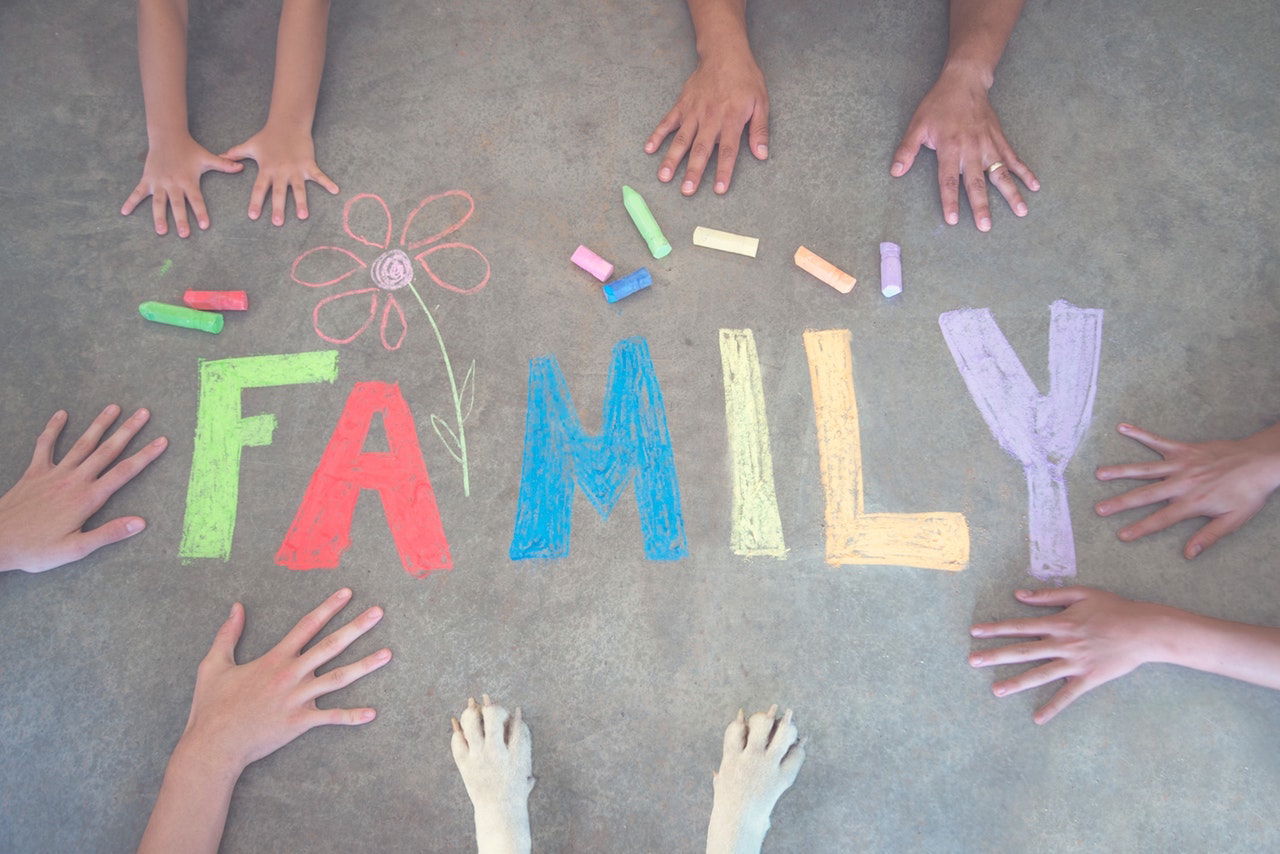Highlights
- Our results suggest that family structure is a signal factor in accounting for real differences in school conduct and school suspensions. Post This
- Policymakers must recognize that social and psychological problems in youth may manifest themselves at school but have their origins in family situations over which the school has little or no control. Post This
- In 2016, nearly 24% of black students in U.S. elementary and secondary schools had been suspended at least once, compared to 8% of white students and 4% of Asian students. Post This
Black students are more likely to get in trouble in school and to end up suspended, compared to white students. This racial disparity in school discipline is both a cause and consequence of enduring racial inequality in America. And it is important because it means that black students, especially black boys, are more likely to end up on the wrong track: getting less schooling, heading towards trouble with the criminal justice system, and, later in life, having fewer opportunities in the labor force.1 What has been called the “school-to-prison pipeline” often starts in the principal’s office and ends in prison, with school suspensions increasing the risk that black boys, in particular, end up incarcerated.2
The Government Accountability Office (GAO) has recently spotlighted racial and ethnic disparities in school disciplinary actions, such as being suspended or expelled from school.3 Figure 1 illustrates this racial inequality, showing that in 2016 nearly 24% of black students in U.S. elementary and secondary schools had been suspended at least once, as our new analysis of the National Household Education Survey (NHES) shows.4 By contrast, only a third as many white students (8%) and one-sixth as many Asian students (4%) had been suspended. There was a slight but significant reduction in the overall frequency of suspensions between 2012 and 2016, as Figure 1 indicates, but large differences across racial groups remained.5
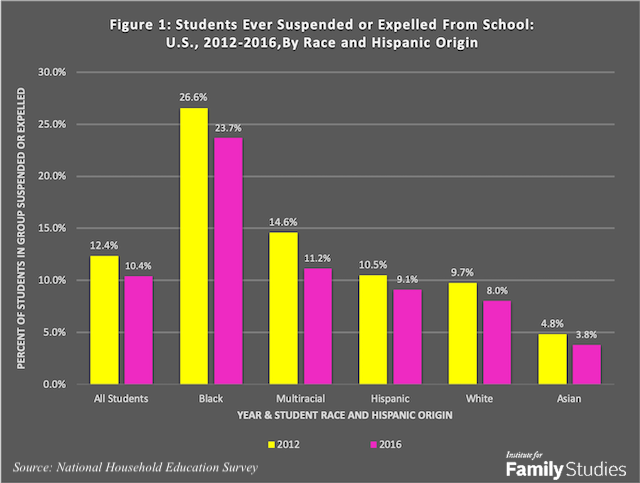
We do not doubt that racial variation in suspensions is partly a consequence of racial prejudice or “implicit bias” on the part of teachers and school administrators. Black students, especially black boys, are more likely to be surveilled and punished for their behavior, even when that behavior is similar to that of white peers who are not disciplined.6 There is also evidence that the racial composition of teachers in schools shapes patterns of school discipline for African American students.7
But there are legitimate reasons for believing that some of the racial differences in school suspensions and discipline are based upon real, not just perceived, differences in students’ behavior.8 We focus here on the possibility that some of these differences are related to family factors, including notable differences in family structure by race. Students who come from chaotic homes, single-parent families, or non-intact families are less likely to get the consistent attention, affection, and discipline they need to flourish and develop self control. Their families typically have less money, which affects the quality of their neighborhoods and their neighborhood peers, which is also an important influence on school conduct. And they are also more likely to be exposed to conflict, stress, frequent moves, and neglect—all risk factors for delinquent and disruptive behavior.9 Indeed, our data indicate that rates of school contact for student misbehavior are nearly twice as high among students living with separated or divorced parents as among those living with stably married parents. And they are higher still among students who live apart from both biological parents, being cared for instead by grandparents or foster parents.10
When it comes to race and family structure, the NHES indicates that black students are far more likely to be living apart from their married birth parents in the home (72%) compared to white students (37%) or Asian students (26%), as shown in figure 2.11 These family structure differences, then, are likely to play a role in inter- and intra-racial disparities in student conduct and discipline.
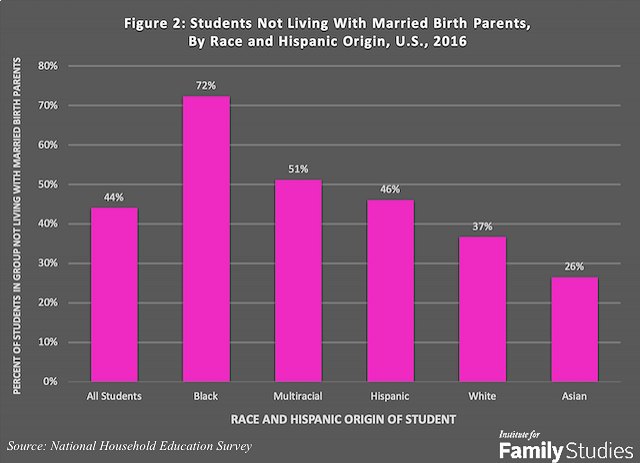
Indeed, among black students who do live with both married birth parents, suspension rates are less than half as large as those for black students living in other family types: 12% versus 28%.12 The suspension rate for black students living in intact families, 12%, is also less than the suspension rate for white students from non-intact families, 13% (see Figure 3 below).
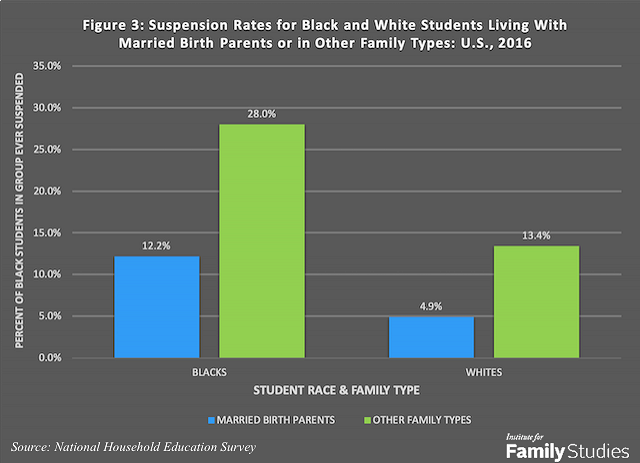
Moreover, our analyses indicate that family structure accounts for a larger share of the racial gap in school suspensions than socioeconomic factors. Table 1 (see Appendix) indicates that controlling for family structure reduces the racial difference in school suspensions by about 55%, whereas controlling for socioeconomic status only reduces it by about 38%. These results, then, suggest that family structure is a signal factor in accounting for real differences in school conduct and school suspensions. This is especially noteworthy because discussions related to racial disparities in school discipline often overlook the role of family structure and highlight socioeconomic explanations.13
Our results suggest that efforts to bridge the racial divide in school discipline must not only focus on school failures to create a safe and equitable school environment but also on family life. Policymakers must recognize that social and psychological problems in youth may manifest themselves at school but have their origins in family situations over which the school has little or no control. Often, we place too much blame on teachers, administrators, and school policies, overlooking the role that factors outside the school’s control—including the quality and stability of family life—have on children’s in-school conduct.
Accordingly, if we seek to reduce the number and rate of black children being suspended in schools, policymakers, educators, civic leaders, and parents themselves need to go beyond just improving the school climate to finding ways to strengthen and stabilize black family life.14 Such efforts should include criminal justice reform, ending marriage penalties in means-tested policies, subsidizing the wages of low-income workers, and launching local and national campaigns directed by black religious, civic, and cultural leaders to strengthen marriage in the black community.15 Efforts like these are needed because, our research suggests, increasing the number of African American children who are raised by stably married parents would dramatically increase the odds that black girls and boys steer clear of the principal’s office—andincrease the odds they flourish in school, avoid contact with the criminal justice system, and, later in life, excel in the labor force further down the road. While they are no panacea, given the racial bias that still shapes school life in America, stronger black families would go a long way towards reducing racial disparities in school discipline.
Nicholas Zill is a research psychologist and a senior fellow of the Institute for Family Studies. He directed the National Survey of Children, a longitudinal study that produced widely cited findings on children’s life experiences and adjustment following parental divorce. W.Bradford Wilcox is a senior fellow of the Institute for Family Studies and the director of the National Marriage Project at the University of Virginia.
Appendix
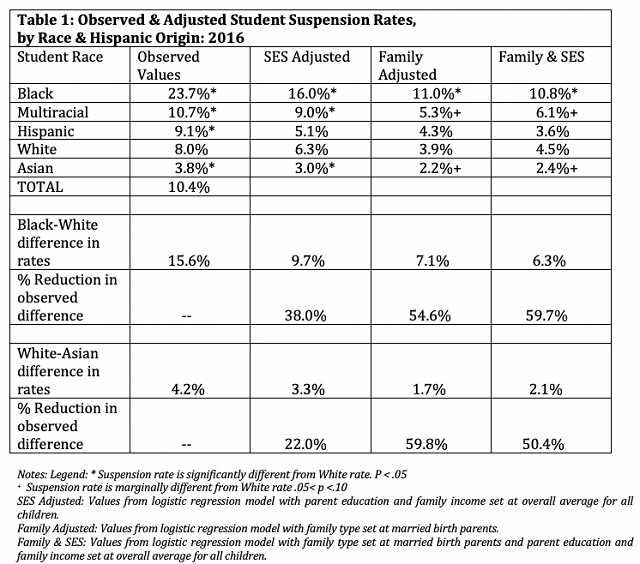
1. Kinsler, Josh, “Understanding the Black-White School Discipline Gap,” Economics of Education Review, 30, no. 6 (2011); L. Lochner, E. Moretti, “The effects of education on crime: Evidence from prison inmates, arrests, and self-reports,”The American Economic Review, 94, no. 1 (2004); J. Grogger, “The effect of arrests on the employment and earnings of young men,” The Quarterly Journal of Economics, 110, no. 1 (1995); and K. C. Monahan, S. VanDerhei, J. Bechtold, E. Cauffman, “From the school yard to the squad car: School discipline, truancy, and arrest,” Journal of Youth and Adolescence, 34, no. 7 (2014).
2. W. C. Jacobsen, G. T. Pace, N. G. Rmirez, “Punishment and inequality at an early age: Exclusionary discipline in elementary school,” Social Forces, 97, no. 3 (2019); A. Bacher-Hicks, S. B. Billings, D. J. Deming, “The school to prison pipeline: Long-run impacts of school suspensions on adult crime,” National Bureau of Economic Research, #26257 (2019); K. Wolf, A. Kupchik, “School suspensions and adverse experiences in adulthood,”Justice Quarterly, 34, no. 3 (2016).
3. U.S. Government Accountability Office. K-12 Education: Discipline Disparities for Black Students, Boys and Students with Disabilities. (Washington, DC: U.S. GAO, March 2018).
4. The National Household Education Survey (NHES) of 2016 was based on parent reports concerning a national probability sample of 14,075 students in elementary, middle, and high schools across the U.S., including a subsample of homeschooled children. See: https://nces.ed.gov/nhes/about.asp
5. Estimates in the text and Figure One are based on authors’ analysis of public use data from the NHES 2016 and the National Household Education Survey of 2012. The sample for the NHES 2012 was a similar national probability sample of 17,563 students in elementary, middle, and high schools across the U.S. The overall difference in suspension rates across the two surveys is statistically significant, but the changes in rates for each of the racial and ethnic groups are not. In both years, black suspension rates were significantly higher than rates for whites, Hispanics, Asians, and multiracial and other students. In 2012, suspension rates for whites were significantly higher than those for Asians, and significantly lower than those for Hispanics and multiracial students. This was not true in 2016, probably because of smaller racial subsample sizes.
6. Cheryl Staats, Implicit Racial Bias and School Discipline Disparities,” Kirwan Institute Special Report, May 2014; Anne Gregory and Rhona S. Weinstein, “The Discipline Gap and African Americans: Defiance or Cooperation in the Classroom,” Journal of School Psychology, 46, no. 4 (2008); Erik Girven, et al., “The relative contribution of subjective office referrals to racial disproportionality in school discipline,” School Psychology Quarterly, 2019; A.C. McFadden, G.E. Marsh, “A study of race and gender bias in the punishment of school children,”Education and Treatment of Children, 15, no. 2 (May 1992); Anne Gregory et. al, “The Achievement Gap and the Discipline Gap: Two sides of the same coin?” Educational Researcher, 39, no. 1 (Jan/Feb 2010). Travis Riddle and Tracy Sinclair, “Racial Disparities in School-Based Disciplinary Actions Are Associated with County-Level Rates of Racial Bias,” PNAS, 116, no. 17 (April 2019).
7. Dorothy Cheng, “Teacher Racial Composition and Exclusion Rates Among Black or African American Students,” Education and Urban Society, 51, no. 6 (2019); C. A. Lindsay, C. M. D. Hart, “Exposure to same-race teachers and student disciplinary outcomes for black students in North Carolina,” Education Evaluation and Policy Analysis, 39, no. 3 (2017); Jamilia J. Blake, et al., “Does Student-Teacher Racial Ethnic Match Impact Black Students' Discipline Risk? A Test of the Cultural Synchrony Hypothesis” in Russel J. Skiba, et al., Inequality in School Discipline(Springer, 2016).
8. Max Eden, Safe and Orderly Schools(The Manhattan Institute, March 14, 2019.) N. Barrett, A McEachin, J. N. Mills, J. Valant, “Disparities in student discipline by race and family income,” Education Research Alliance for New Orleans, 2018; J. P. Wright, M. A. Morgan, M. A. Bolger, K. M. Beaver, “Prior problem behavior accounts for the racial gap in school suspensions,” Journal of Criminal Justice, 42, no. 3 (2014); M. Petrilli, “Why disparate impact theory is a bad fit for school discipline,” Flypaper Blog, Thomas B. Fordham Institute, 2018, citing U.S. Department of Education, High school longitudinal study of 2009 (National Center for Education Statistics, 2009).
9. Paul Amato, Alan Booth, Sara McLanahan, and Gary Sandefur, Growing Up with A Single Parent(1994). David Autor and Melanie Wasserman, Wayward Sons: The Emerging Gender Gap in Labor Markets and Education, (Thirdway, Next, April 2014); T. Loveless, Racial Disparities in School Suspensions, Brookings Institution, Brown Center Chalk Board, 2017;B. A. Jacob, J. Ryan, “How life outside of a school affects students’ performance in school,” Brookings Institution, March 22, 2018. NU Cotton, et al., “Aggression and fighting behavior among African American adolescents: individual and family factors,” American Journal of Public Health, 84, no. 4 (April 1994).
10. Estimates derived from authors’ analysis of public use data file from the NHES 2016. One or more contacts by the school for student behavioral issues were reported for 13% of those living with married birth parents, 23% of those living with a birth parent and stepparent, 23% of those living with their birth father only, 24% of those living with a separated of divorced birth mother, 30% of those living with never married mothers, 34% of those living with grandparents, 35% of those living with adoptive parents, and 44% of those living with foster parents or other guardians. For a similar analysis, see: Anna Egalite, “How Family Background Influences Student Achievement,” Education Next, 16, no. 2 (Spring 2016).
11. Estimates based on authors’ analysis of public use data from the 2016 NHES (see above). The proportion of black students not living with married birth parents is significantly higher than the parallel proportions for whites, Hispanics, Asians, and multiracial and other students. The white proportion is significantly higher than the Asian proportion and significantly lower than the Hispanic and multiracial proportions.
12. Estimate based on authors’ analysis of public use data from the 2016 NHES. The difference in suspension rates between black students living with married birth parents and black students living in other family types is statistically significant.
13. R. J. Skiba, R. S. Michael, A. C. Nardo, R. L. Peterson, “The color of discipline: Sources of racial and gender proportionality in school punishment,” The Urban Review, 34, no. 4 (2002); E. Brantlinger, “Social class distinctions in adolescents’ reports of problems and punishment in school,” Behavioral Disorders, 17, no. 1 (1991); D. Kearns, RELEASE: Rescinding Obama Discipline Guidance Could Exacerbate Disparities Among Students of Color, Students With Disabilities, Low-Income Students, Center for American Progress, 2018; R. D. Kahlenberg, “Where ‘no-excuses’ pedagogy fails low-income students,” The Century Foundation, 2019.
14. Autor and Wasserman, Wayward Sons; Orlando Patterson, Rituals of Blood (Washington, DC: Civitas Counterpoint, 1998). John P. Wright, et al., “Prior Problem Behavior Accounts for the Racial Gap in School Suspensions,” Journal of Criminal Justice, 2014; S. B. Sheldon, J. L. Epstein, “Improving student behavior and school discipline with family and community involvement,” Education and Urban Society, 35, no. 1 (2002); S. Kim, J. Mazza, J. Zwanziger, D. Henry, “School and behavioral outcomes among inner-city children: Five-year follow-up,” Urban Education, 49, no. 7 (2013); E. J. Olzer, I. Lavi, L. Douglas, J. P. Wolf, “Protective factors for youth exposed to violence in their communities: A review of family, school, and community moderators,” Journal of Clinical Child & Adolescent Psychoology, 46, no. 3 (2017).
15. Brad Wilcox, Joseph Price, and Angelia Rachidi, Marriage Penalized (Washington, DC and Charlottesville, VA: AEI and IFS, 2016). See also: Wilcox, Wendy Wang, and Ronald Mincy, Black Men Making It in America(Washington, DC and Charlottesville, VA: AEI and Institute for Family Studies, 2018).







